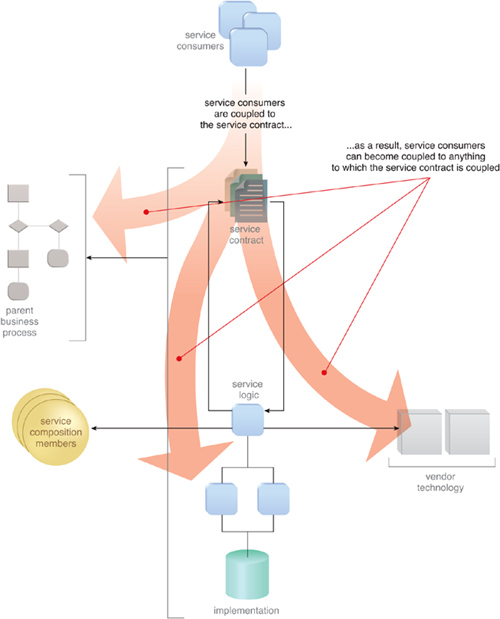The goal of the Service Loose Coupling
principle is to allow services to develop and evolve with minimal
impact on each other, a consideration that is key to achieving the
Increased Organizational Agility goal of service-oriented computing.
This principle is
primarily concerned with design-time dependencies, with a particular
focus on the technical service contract. Coupling considerations apply,
regardless of service implementation medium.
When applying the Service Loose Coupling principle to a service architecture, we need to understand the different kinds of coupling (good and bad) that can exist.
logic-to-contract coupling–
This refers to the coupling of the internal service logic to the
service contract. It is generally considered a positive form of coupling
that preserves the service contract’s independence from the underlying
service implementation.
contract-to-logic coupling–
The opposite of logic-to-contract coupling is contract-to-logic
coupling. When the service contract is dependent on the underlying
service logic, it results in an architecture contrary to the goals of
the Service Loose Coupling
principle because changes to the logic can impact the service contract
and, consequently, service consumers that have formed dependencies on
the service contract.
contract-to-technology coupling– Similar
to contract-to-logic coupling, this negative coupling type results from
forcing service consumers to bind to a platform-specific technology
protocol in order to invoke a service. For example, expecting consumers
to send a serialized DataSet object to a WCF service or returning such an object to the consumer will introduce this kind of coupling.
contract-to-implementation coupling–
This type of negative coupling results from directly expressing
characteristics of the underlying service implementation (the physical
data models of databases or APIs of legacy software, for example) within
the service contract.
contract-to-functional coupling–
This negative coupling type can sneak into a service when generic logic
is designed with a particular business process or pre-built consumer in
mind. As a result, the service contract can become dependent on the
underlying functionality.
consumer-to-implementation coupling– This form of negative coupling occurs when the Contract Centralization
pattern is not consistently applied. Allowing consumer programs to
bypass a published technical contract in order to directly access
underlying resources was also a common side-effect of point-to-point
integration architectures.
consumer-to-contract coupling–
A positive coupling type that results from service consumers having
limited access to the service contract. Consumer-to-contract coupling is
the desired result of Contract Centralization .
Note how all described coupling types revolve around how the service contract is defined and architecturally positioned (Figure 1).
